How to Make DIY Money Envelopes: A Detailed Guide
Creating your own money envelopes can be a fun and rewarding project. Not only does it allow you to personalize your envelopes, but it also gives you the opportunity to save money on store-bought options. Whether you’re looking to organize your finances or simply add a touch of creativity to your daily routine, here’s a step-by-step guide on how to make DIY money envelopes.
Materials Needed

Before you start, gather the following materials:
- Plain paper or cardstock
- Scissors or a paper cutter
- Glue or double-sided tape
- Optional: Decorative paper, stamps, or stickers
Step 1: Choose Your Paper

Select a paper that suits your needs. If you’re looking for a sturdy option, cardstock is a great choice. For a more delicate look, you can use plain paper. If you want to add a personal touch, consider using decorative paper or even fabric.
Step 2: Cut Your Paper

Measure and cut your paper to the desired size. A common size for money envelopes is approximately 5.5 inches by 8.5 inches. If you’re using cardstock, you may need to score the paper before folding it to ensure a clean crease.
Step 3: Create the Envelope Shape
With your paper cut to size, fold it in half lengthwise to create the basic envelope shape. If you’re using cardstock, score the fold line with a bone folder or the back of a ruler to help it fold more easily.
Step 4: Add Flaps and Seams
Unfold the paper and fold the top and bottom edges inward, creating flaps. Then, fold the top and bottom flaps down to form the envelope’s seams. You can use glue or double-sided tape to secure the seams, ensuring they are sealed tightly.
Step 5: Decorate Your Envelope
Now it’s time to add your personal touch. You can use stamps, stickers, or even hand-drawn designs to decorate your envelope. If you’re using decorative paper, you may not need to add any additional decorations.
Step 6: Add a Closure
For a simple closure, you can fold the top flap down and secure it with a piece of tape. If you want a more elegant option, consider adding a button and a loop made from ribbon or string. Punch a hole in the top of the envelope and thread the ribbon through the hole, creating a loop to hold the button in place.
Step 7: Fill Your Envelope
Once your envelope is decorated and sealed, it’s ready to be filled with cash or checks. Be sure to fold the money or checks neatly before placing them inside the envelope to prevent any creases or damage.
Step 8: Use and Store Your Envelopes
Now that your DIY money envelopes are complete, you can use them to organize your finances, store cash, or even give as gifts. If you plan to store your envelopes for an extended period, consider placing them in a protective sleeve or box to keep them clean and in good condition.
Additional Tips
Here are a few additional tips to help you create the perfect DIY money envelopes:
- Practice folding and sealing the envelopes before you start the project to ensure you’re comfortable with the process.
- Keep your envelopes in a designated spot to avoid losing them.
- Experiment with different designs and closures to find what works best for you.
Creating your own money envelopes can be a fun and rewarding project that adds a personal touch to your daily routine. With this detailed guide, you’ll be able to make beautiful, functional envelopes that suit your needs and style.



